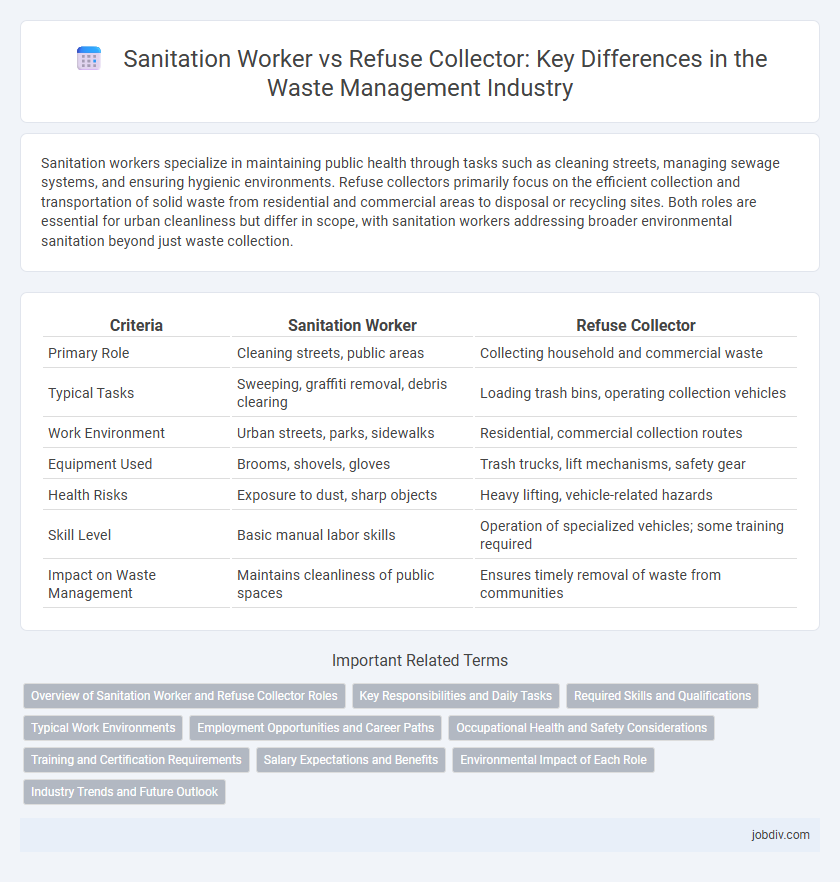Sanitation workers specialize in maintaining public health through tasks such as cleaning streets, managing sewage systems, and ensuring hygienic environments. Refuse collectors primarily focus on the efficient collection and transportation of solid waste from residential and commercial areas to disposal or recycling sites. Both roles are essential for urban cleanliness but differ in scope, with sanitation workers addressing broader environmental sanitation beyond just waste collection.
Table of Comparison
| Criteria | Sanitation Worker | Refuse Collector |
|---|---|---|
| Primary Role | Cleaning streets, public areas | Collecting household and commercial waste |
| Typical Tasks | Sweeping, graffiti removal, debris clearing | Loading trash bins, operating collection vehicles |
| Work Environment | Urban streets, parks, sidewalks | Residential, commercial collection routes |
| Equipment Used | Brooms, shovels, gloves | Trash trucks, lift mechanisms, safety gear |
| Health Risks | Exposure to dust, sharp objects | Heavy lifting, vehicle-related hazards |
| Skill Level | Basic manual labor skills | Operation of specialized vehicles; some training required |
| Impact on Waste Management | Maintains cleanliness of public spaces | Ensures timely removal of waste from communities |
Overview of Sanitation Worker and Refuse Collector Roles
Sanitation workers are responsible for maintaining public health by cleaning streets, collecting waste, and ensuring proper disposal of refuse to prevent environmental contamination. Refuse collectors specialize in the systematic collection and transportation of household and commercial waste to designated disposal or recycling facilities. Both roles play a critical part in waste management systems, contributing to community cleanliness and environmental sustainability.
Key Responsibilities and Daily Tasks
Sanitation workers are primarily responsible for maintaining public hygiene by cleaning streets, parks, and public spaces, often handling biohazardous waste and ensuring proper disposal to prevent health risks. Refuse collectors focus on the collection, transportation, and disposal of household and commercial waste, operating specialized vehicles and managing waste sorting at designated facilities. Both roles require adherence to safety protocols, use of protective equipment, and coordination with municipal waste management systems to promote environmental cleanliness.
Required Skills and Qualifications
Sanitation workers typically require knowledge in waste management techniques, physical stamina, and adherence to safety protocols to handle hazardous materials effectively. Refuse collectors need skills in operating waste collection vehicles, route navigation, and customer service to ensure efficient and timely garbage pickup. Both roles demand understanding of environmental regulations and teamwork, but refuse collectors often require commercial driver's licenses and mechanical aptitude for vehicle operation.
Typical Work Environments
Sanitation workers typically operate in residential neighborhoods, public parks, and commercial areas, handling the collection, cleaning, and maintenance of streets and public facilities. Refuse collectors primarily work on garbage collection routes, including curbside pickup in urban and suburban areas, often using specialized trucks to collect household and commercial waste. Both roles require navigating outdoor environments, but refuse collectors spend more time on vehicle operations and waste loading, while sanitation workers focus on broader public hygiene tasks.
Employment Opportunities and Career Paths
Sanitation workers and refuse collectors both play crucial roles in waste management, yet their employment opportunities and career paths differ significantly. Sanitation workers often have broader responsibilities, including cleaning public spaces and managing hazardous waste, leading to diverse advancement options in environmental services or public health sectors. Refuse collectors typically focus on residential and commercial waste collection, with potential career growth in fleet management or logistics within waste disposal companies.
Occupational Health and Safety Considerations
Sanitation workers and refuse collectors face distinct occupational health and safety risks, with sanitation workers often exposed to hazardous biological waste and refuse collectors encountering heavy machinery and vehicle-related dangers. Implementing proper personal protective equipment (PPE) such as gloves, masks, and high-visibility clothing is essential to mitigate risks like sharp objects, chemical exposure, and traffic accidents. Regular training on safe waste handling protocols and ergonomic practices significantly reduces injury rates and promotes long-term health in these high-risk occupations.
Training and Certification Requirements
Sanitation workers typically require training in waste handling, health and safety protocols, and the operation of sanitation equipment, often supported by certifications in hazardous materials handling or OSHA standards. Refuse collectors must complete formal training programs covering waste collection techniques, vehicle operation, and environmental regulations, with certifications such as Commercial Driver's License (CDL) and occupational safety credentials. Both roles emphasize compliance with local and federal waste management regulations to ensure efficient and safe waste disposal practices.
Salary Expectations and Benefits
Sanitation workers typically earn an average annual salary ranging from $30,000 to $45,000, with benefits including health insurance, retirement plans, and paid leave, reflecting the physically demanding nature of their job. Refuse collectors generally have a comparable salary range but may receive higher overtime pay due to irregular hours and extra shifts required for waste collection. Both roles offer job stability and union representation, enhancing long-term benefits and workplace protections in the waste management sector.
Environmental Impact of Each Role
Sanitation workers primarily handle the safe disposal and treatment of waste, reducing environmental pollution by preventing hazardous material contamination. Refuse collectors focus on the efficient collection and transportation of solid waste, minimizing landfill overflow and promoting recycling efforts. Both roles are crucial in managing waste sustainably, but sanitation workers directly impact soil and water quality, while refuse collectors influence waste stream management and resource recovery.
Industry Trends and Future Outlook
Sanitation workers and refuse collectors are evolving roles within the waste management industry, driven by advancements in automation and sustainability initiatives. Industry trends highlight a growing emphasis on smart waste collection technologies and environmentally friendly practices, reshaping job responsibilities and enhancing operational efficiency. The future outlook anticipates increased integration of AI-powered systems and green policies, focusing on reducing landfill dependency and promoting circular economy models.
Sanitation Worker vs Refuse Collector Infographic

 jobdiv.com
jobdiv.com